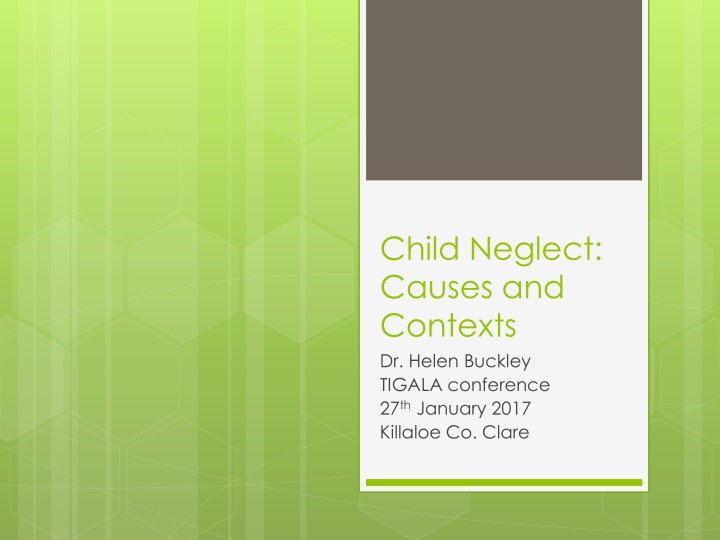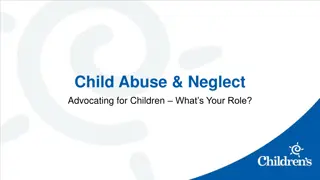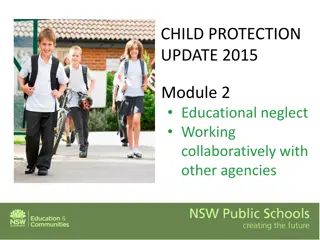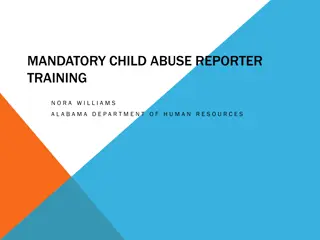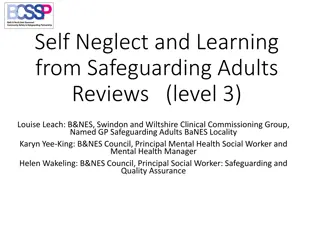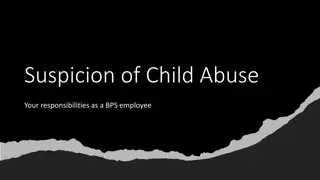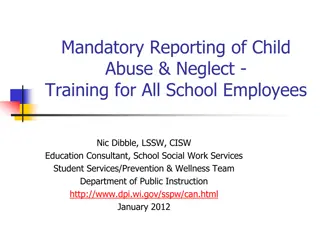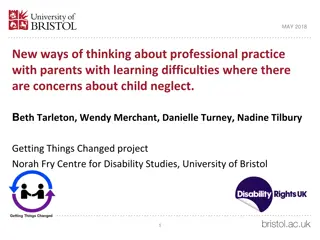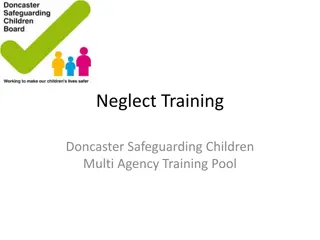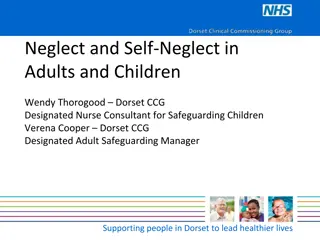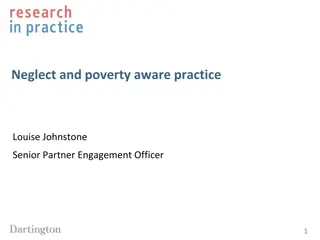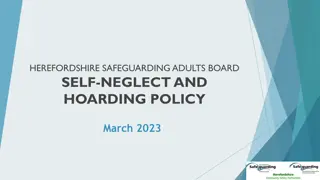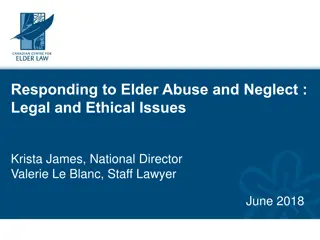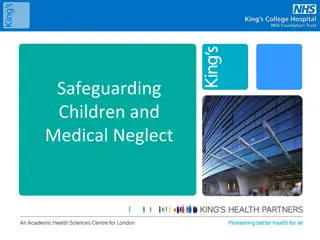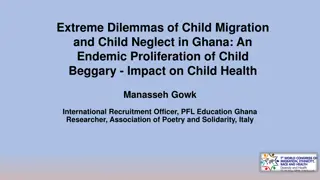Child Neglect Causes and Contexts
Child neglect is a complex issue often intertwined with various factors such as living conditions, parental behavior, and societal contexts. Despite being unintentional, neglect can have serious implications on a child's development. Professionals face challenges in managing neglect due to outdated knowledge, lack of consideration for children's experiences, and conflating neglect with vulnerability. It is crucial to address neglect comprehensively, considering its impact on various aspects of a child's well-being.
Uploaded on Apr 19, 2025 | 4 Views
Download Presentation

Please find below an Image/Link to download the presentation.
The content on the website is provided AS IS for your information and personal use only. It may not be sold, licensed, or shared on other websites without obtaining consent from the author.If you encounter any issues during the download, it is possible that the publisher has removed the file from their server.
You are allowed to download the files provided on this website for personal or commercial use, subject to the condition that they are used lawfully. All files are the property of their respective owners.
The content on the website is provided AS IS for your information and personal use only. It may not be sold, licensed, or shared on other websites without obtaining consent from the author.
E N D
Presentation Transcript
Child Neglect: Causes and Contexts Dr. Helen Buckley TIGALA conference 27thJanuary 2017 Killaloe Co. Clare
Why is neglect complicated? We all know what neglect is, but it can be difficult to communicate what we think about it It should be about the impact on the child s development but is often described in terms of the context (Homeless, poor), other times in technical terms (omission of basic care) parental behaviour or factors (alcohol use, intellectual disability) Unlike other forms of child harm, t is often unintentional For the same reason, it is difficult to estimate its prevalence It rarely produces a crisis It is rarely isolated The boundaries between neglect and disadvantage are interpreted differently in different contexts
Child Neglect In terms of understanding, the interaction of all the different factors best explains what it means, how it emerged and what might be best to address it.
Statistics Tusla child protection referrals In Quarter 1 2016 there were 11,211, reports defined as neglect , which represented 25% of all reports. The highest proportion was 37%. No breakdown of welfare but around 60% are in the welfare category and probably relate to neglect in what is considered a less serious form
Challenges to professional management of child neglect Lack of up to date knowledge and failure to put research evidence to use Failure to consider children s lived experiences- not talking to children Superficial compliance of families Failure to consider different contexts Failure to fully assess parental mental health as well as motivation and general capacity Conflation of neglect with vulnerability
Child Neglect: cause and effect (Dubowitz 1999) Inadequate food failure to develop Household hazards accidents Lack of hygiene health problems Lack of attention to health disease Inadequate mental health care suicide or delinquency Inadequate emotional care behaviour and educational Inadequate supervision risk taking behaviour Unstable relationship attachment problems Unstable living conditions behaviour & anxiety Exposure to domestic violence behaviour and health Community violence - anti social behaviour
Understanding different contexts and causes Parental factors Family functioning Impact on children
Pre disposing factors that inevitably impact on parenting Poor history of being parented Intellectual disability Personality disorder Some forms of mental illness
Current factors that may affect parenting and are strongly associated with neglect Drug use Alcohol use Recent bereavement Depression Domestic violence Poverty and homelessness The above factors are present in many families that do not neglect their children although they can have significant short term effects on capacity. Family functioning is the key.
Family Functioning Tend not do directly seek help, to be resistant to intervention, Generally poor at attending appointments Tend to be open to child protection services for years with little progress Tend to lurch from crisis to crisis, difficulty managing money and accommodation often have little insight and low motivation to change
Value of using family functioning as a lens It explains why some cases of neglect are associated with particular factors while others are not It clarifies for practitioners that approaches and practice tools must be tailored to the functioning capacity of a family It highlights that addressing adverse factors without attending to family functioning will be ineffective in dealing with neglect, e.g. providing housing or using abstinence from drugs or alcohol as a condition for reunification It allows for an assessment of mental health and its impact on parenting instead and avoids focusing on capacity to perform basic parenting tasks
Family Functioning what does research say Gaudin et al (1996) on the basis of observational research show that neglectful families (in comparision with matched, non- neglectful families) display less ability to resolve conflicts, less cohesion, less clear boundaries, poor negotiating skills, poor leadership (weak or autocratic), minimal paternal involvement, less warmth or empathy and more chaos All of the above mean that it is less easy to parent if adverse factors are present
Family Functioning what does research say Crittenden ( in Dubowitz, 1999) identifies information processing as the key to understanding family functioning as a cause of neglect and considers three types of neglect. Disorganised neglect Emotional neglect Depressed neglect
Disorganised Neglect Affect is dominant and cognition minimal Family members organise their behaviour according to how they feel, not according to plan or method Response to children becomes unpredictable
Disorganised Neglect: impact on children Children learn to emphasise affect and discard cognitive information, e.g. Become very demanding and unable to accept delay or compromise Children learn to manipulate and to distrust cognition Children may suffer neglect through lack of food because of poor financial planning, lack of heat because bills may not have been paid. Promotes enmeshment May be repeated inter-generationally
Emotional neglect Families where affect is low and cognition is high Highly structured, with many rules, emphasis on neatness Few overt displays of warmth or affection Relationships are defined by performance
Emotional Neglect: impact on children Attachment disorder May become compulsively care giving May become isolated Depend on cognitive rules to guide their behaviour
Depressed Neglect Carers withdrawn and dull Do not perceive children s needs or notice that certain actions need to be taken Do not believe anything will change Little affectionate play or soothing contact
Family functioning and social networks McSherry (2004) elaborates that neglecting parents tend to believe that they have little control over their situations and therefore have low aspirations He suggests that they have problematic relationships with employers, with partners, with landlords and lack understanding of the subtleties and complexities of relationships Systematic reviews have found that parents who neglect their children have or perceive that they have few individuals in their social networks
Gender and neglect Very little evidence on neglect relates to fathers, which tends to reinforce practitioner tendencies to focus on mothers.
Cumulative Harm Reports not normally reaching the threshold for involvement Accumulation of a single adverse circumstance or event, or by multiple different circumstances and events. The unremitting daily impact of these experiences on the child can be profound and exponential Unlikely to receive a report explicitly due to cumulative harm
Adolescent Neglect (Rees et al 2011) May still be impacted by parental factors which decrease parental availability Even if the young person is in care, they are likely to be suffering from the impact of earlier neglect Adolescents are more likely to be left alone, lack supervision and positive role modelling This leads to more risk taking behaviour May have to take on the role of carer May not receive support at key developmental stages
Parental Factors: substance misuse Substance misuse is the strongest predictor of child neglect (Daniel et al, 2011) Effects on parenting include directing funds towards drugs rather than food or other children s needs, disrupted routines, children missing school, parental mood swings (McKeganey et al, 2002) Other factors that come into play include the age of the parent, and number of other risk factors. The more risk factors alongside substance abuse, the more likely that neglect will occur. Substance using parents are less likely to be able to develop healthy authoritative parenting styles, tend to be less responsive and more authoritarian (NACD 2011)
Impact on children of parental factors: substance misuse during pregnancy (physical effects) 2011 NACD report gives full literature review Women who misuse drugs are less likely to attend ante natal appointments Problem alcohol use during pregnancy has been linked to increased risk of spontaneous abortion, intrauterine growth retardation, low birth-weight, learning disabilities, hyperactivity and foetal alcohol spectrum disorder
Impact on children of parental factors: substance misuse during pregnancy (physical effects) Opiates used in pregnancy can case problems with the nervous system, heart defects, spina bifida, gastric problems and withdrawal symptoms. Methadone use causes withdrawl symptoms. Cocaine use is associated with developmental problems, low birth weight and behavioural deficits including ADD, and cognitive ability Amphetamine use in pregnancy is associated with congenital malformations
Impact of parental drug use on children Babies can be born with addictions Children likely to be punished more and physically abused more Parental cocaine use has been associated with sexual abuse of children Family disruption is more likely Physical neglect is likely Emotional abuse (worry, stress on the part of the child)
Impact of parental substance misuse on children Research shows that children are at higher risk of a range of outcomes in all areas of health, safety, and emotional and social development Child abuse cases involving parental substance abuse are associated with longer stays in foster care and reduced likelihood of reunification Families are less cohesive, have lower levels of expression of warmth and caring and higher levels of unresolved conflict and arguing
Parenting Factors: Domestic Violence (Holt et al, 2008) Maternal stress and depression as a result of domestic violence can result in emotional distance, unavailability and abuse DV can prevent mothers from developing authority and control Fear may cause mothers to deny their children normal transitions, basic trust and security Abusive fathers are less likely to be involved with their children, are more controlling, authoritarian and less consistent, and are poorer role models
Impact on young people of parental domestic violence Re-victimisation, male abusive behaviour, tuning out care-taking roles, Multiple stressors can accumulate including substance misuse, crime, dropping out of education and disengagement, risk taking behaviour
Key points Child neglect is strongly connected to other forms of child harm Parental factors are mediated by the carers personalities and experience which may be affected by mental health Both factors are essential to assessment and intervention
